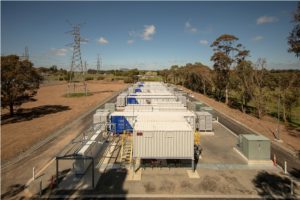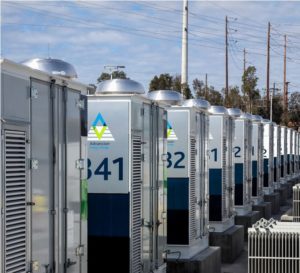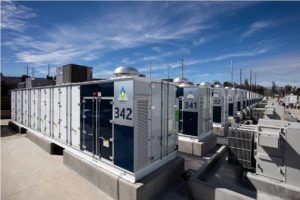 Fluence, an energy storage technology company jointly owned by Siemens and AES, was in the news recently as it supplied its “Advancion” technology to India’s first grid-scale battery-based energy storage system. This 10-mw system, owned by AES and Mitsubishi, is located at Tata Power Delhi Distribution Ltd’s Rohini substation. T&D India caught up with Rupam Raja, Marketing Director — India and Southeast Asia, Fluence Energy, to understand Fluence’s prowess in energy storage. Raja also discusses why India, especially after regulators are seen opening up to new technologies, is a big market for Fluence.
Fluence, an energy storage technology company jointly owned by Siemens and AES, was in the news recently as it supplied its “Advancion” technology to India’s first grid-scale battery-based energy storage system. This 10-mw system, owned by AES and Mitsubishi, is located at Tata Power Delhi Distribution Ltd’s Rohini substation. T&D India caught up with Rupam Raja, Marketing Director — India and Southeast Asia, Fluence Energy, to understand Fluence’s prowess in energy storage. Raja also discusses why India, especially after regulators are seen opening up to new technologies, is a big market for Fluence.
Fluence represents the coming together of two giants – AES and Siemens. Presuming that both partners were independently undertaking energy storage projects, what was the main rationale behind creating a partnership?
The market for energy storage continues to expand, estimated by Bloomberg New Energy Finance, to reach a cumulative $620 billion of investment by 2040. Fluence’s team has led the market through the first decade of energy storage. Fluence was created to be a leading partner going forward, combining the engineering, product development, implementation and services capabilities of our predecessors—AES Energy Storage and Siemens’ energy storage teams.
As Fluence, we are a unique partner who can provide industrial-strength storage solutions, deeply understands the power sector, and who has a track record of safely deploying and operating energy storage, combined with the staying power and financial stability needed to ensure a good long-term relationship.
What is the current energy storage portfolio of Fluence globally and what is the broad geographic distribution?
 Fluence has built on more than a decade of grid-scale energy storage installations and currently has more than 760 mw of battery-based energy storage systems deployed or contracted across 17 countries, the largest advanced battery-based energy storage fleet in the world.
Fluence has built on more than a decade of grid-scale energy storage installations and currently has more than 760 mw of battery-based energy storage systems deployed or contracted across 17 countries, the largest advanced battery-based energy storage fleet in the world.
Countries where Fluence has deployed energy storage projects in include the United States, the Dominican Republic, Chile, across Europe (including 120 mw of projects in the UK announced last year), Australia and the Philippines, among others. In the last year, Fluence has also deployed the first grid-scale battery-based energy storage projects in Brazil and India.
The 10-mw energy storage project for Tata Power in India is the biggest such in south-east Asia. How was the overall experience?
The willingness of regulators in India to adopt new technologies that allow us to leapfrog infrastructure issues of the past is very encouraging. TPDDL hosting this 10-mw asset in the Delhi load center is also testimony to the technical mindset and maturity of Tata Power and its commitment to making step changes to address power distribution issues in the country. We were never short on local skills in India to put this asset on the ground in a period of 10 months.
Tell us more about Fluence’s “Advancion” technology. What advantage does this offer to customers?
Fluence’s Advancion platform delivers unbeatable dependability with industry-leading reliability, uptime, and years of safe operation, built from a redundant architecture with safety designed into every layer of the architecture. Advancion is often used for larger projects designed to deliver frequency regulation, capacity peak power, and T&D enhancement, but is competitive for midsize and large commercial and industrial applications.
India is pushing for renewable energy capacity addition but has to contend with potential grid instability. Tell us how energy storage systems can help maintain grid stability.
 Indian energy production has previously been based on steady and highly predictable electricity generation from coal. With the rapid adoption of renewable energy resources on the grid, India is adding significant quantities of clean cheap energy, but also introducing volatility onto India’s grid that requires management to ensure reliability.
Indian energy production has previously been based on steady and highly predictable electricity generation from coal. With the rapid adoption of renewable energy resources on the grid, India is adding significant quantities of clean cheap energy, but also introducing volatility onto India’s grid that requires management to ensure reliability.
Deploying energy storage on the grid in shorter durations enables better integration of solar and wind power, injecting power when solar production is ramping down, as well as ensuring regulation of both voltage and frequency. Storage can also capture over-generation of solar power when electricity demands are lower.
In longer durations, storage can increase solar and wind power’s value by providing firm, predictable blocks of renewable energy, capturing it when it is generated and dispatching it when it’s needed. Making renewable energy dispatchable also allows it to be bid into the market much in the same way as traditional methods of generation.
How do you therefore see the business potential in India? Some estimates put India’s energy storage potential at 300 GW by 2025.
Battery-based energy storage is a very versatile resource, possibly the most versatile in the hands of the power sector. In India we see huge potential for energy storage, especially with respect to the goals that India has for integrating wind and solar into the generation mix and reducing the percentage of coal in the overall energy mix.
There is sufficient capacity in the transmission sector at the national level currently but as the electricity network further expands and is modernized, there is critical role energy storage to play in optimizing capital expenditures. At the local and regional level the distribution system is ill-equipped to handle the demand growth and expansion of load pockets. Battery storage will play a key role in enabling the network to accommodate that growth.
In the short term, we expect to see commercial and industrial electricity customers using battery storage to improve their quality of power, reduce energy costs and decrease use of fossil fuels. The full extent of business potential is closely tied to the price of batteries (at the pack level), which has declined 85 per cent in the last eight years, according to Bloomberg New Energy Finance.
We gather that energy storage systems still attract high capital costs. What is your view? Do you expect costs to progressively come down, perhaps due to better economies of scale?
India has urgent reliability needs that battery-based energy storage is able to address today at the scale India requires. Battery prices have fallen steadily in the last five years, but recent projections from Bloomberg New Energy Finance don’t expect as significant price declines in the near future. Therefore, there is not a significant advantage to be gained by waiting.
Much of India’s power grid is still in the hands of government utilities that are not in the best of financial health. Do you have any views on this?
Battery storage has a role to play in improving the financial health of those entities. Take the example of rural, agricultural load. Currently, rural distribution networks are serviced at a huge cost – there are leakages in this type of network and the ability of the customer to pay is limited. By coupling battery-based energy storage with solar, the government can meet this demand locally during the day and into the night, cut down the distribution cost and reduce losses from leakages and theft. This opportunity needs to be evaluated in more detail.
What are the typical challenges associated with the implementation of energy storage projects?
 The permitting requirements for an energy storage project are similar to those of a building project, plus the need for a grid connection. There are no new risks that are added from a project development perspective. In fact, since battery storage has no air or wastewater emissions or noise, the land requirements are small and because the project can be built in less than 12 months, the project development risks are much smaller.
The permitting requirements for an energy storage project are similar to those of a building project, plus the need for a grid connection. There are no new risks that are added from a project development perspective. In fact, since battery storage has no air or wastewater emissions or noise, the land requirements are small and because the project can be built in less than 12 months, the project development risks are much smaller.
The only issue we want to highlight is that the current regulatory framework does not recognize the full benefits that energy storage provides to the electricity network. We believe that battery storage should be considered as a generation and transmission resource, and all of its benefits to the grid – particularly the ability to both charge and discharge, and its ability to respond to grid conditions within milliseconds – should be properly valued.
Diesel generation sets are still deployed in remote Indian locations where grid power is largely unreachable. Please discuss how energy storage solutions, perhaps in conjunction with renewable energy sources, can offer a better alternative.
In remote areas that lack access to electricity today, energy storage can be paired with renewable generation to extend safe, reliable and affordable power to communities that will improve their quality of life. In utility-scale applications, integrating solar power with storage increases solar power’s value play by enabling firm, predictable blocks of renewable energy that can be dispatched in the same way as traditional methods of generation.
We also learn that energy storage solutions can help optimize the load on existing transmission lines. Please elaborate.
Utilities in other markets are seeing that there are certain cases where energy storage can defer investments in a variety of fundamental, single-function grid assets like wires, poles, transformers and substations, and in the process help utilities get the most value from the transmission and distribution lines they already own and use.
Energy storage can also provide much-needed distribution capacity in India’s megacities, where communities and industries are growing quickly and space is at a premium. Battery-based energy storage has a smaller footprint than traditional grid infrastructure, and can provide additional benefits like frequency and voltage regulation and the capability to add additional storage as needed, all at a similar cost.
Which countries or regions are likely to dominate Fluence’s business in the coming years? How is India placed in the scheme of things?
Many markets are embracing storage and continue to grow their adoption of the technology. What we have seen is that as utilities in a market build their first projects and learn more about the applications and benefits energy storage can provide, they tend to adopt it more. The United States, Australia, the United Kingdom and Ireland are all building quite a bit of storage, but other countries in our region are following suit, like South Korea and the Philippines.
In India, recent reports points to an immediate need of 3-5 GW of fast-response resources like energy storage to regulate frequency across the nation. However, given the high amount of solar coming online and the accompanying need for flexible resources to support the evening ramp, India needs to set its sights higher, with a more ambitious strong target with a requirement for cost-effectiveness to ensure value for investment.


